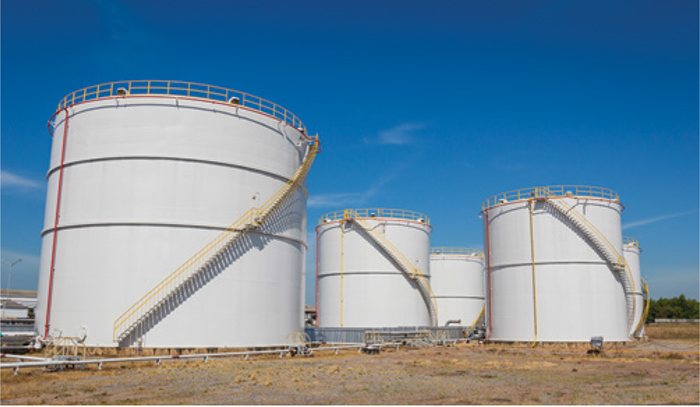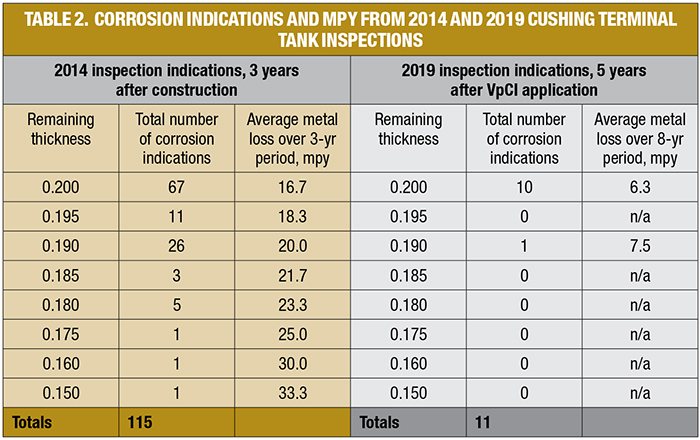Potential maintenance and repair cost savings are significant when employing vapor corrosion inhibitors either as a standalone mitigation technique, or as a complement to conventional cathodic protection methods, in aboveground storage tanks
Mitigation of external corrosion on the bottoms of aboveground storage tanks (ASTs) can have a major impact on overall safety and asset repair costs. Given the critical nature of tank integrity for ASTs that hold hydrocarbons or other hazardous materials (Figure 1), periodic inspections are done to check tank-bottom integrity. Due to the time- and labor-intensive process of draining the tank products and cleaning sludge out of ASTs to prepare for out-of-service API 653 inspections — a standard developed by the American Petroleum Institute providing the most definitive data source for evaluating AST corrosion-mitigation effectiveness — operators are working diligently to extend inspection intervals from 10 years to 20 years. Tank owners must utilize all protective mechanisms that will give them sufficient confidence to do so. Tank owners and operators have multiple reasons and motivations to employ additional methods of corrosion protection to supplement, and sometimes replace, the industry standard method, cathodic protection (CP).

FIGURE 1. Aboveground storage tanks can experience severe corrosion, and special care must be taken to avoid damage in tanks holding hydrocarbons or other hazardous materials
For many years, a vapor corrosion-inhibitor technology, CorroLogic VpCI, has been under examination, both as a standalone AST corrosion-mitigation solution, and as a complementary solution used in conjunction with CP. Recent data from a tank in Cushing, Okla., provide an example of a direct correlation between corrosion reduction and the use of CorroLogic VpCI.
The soil-side corrosion problem
AST bottoms are typically uncoated and are located in contact with a perfect environment to promote corrosion due to a multitude of factors. Sand tank pads can also foster microbiologically induced corrosion (MIC). In some regions, such as the Middle East, the sand often contains high levels of minerals or corrosive salts (Sabkha soil) that exacerbate the corrosion problem. Sometimes, corrosion occurs even when appropriate preventative measures are taken, as was the case at the Cushing crude-oil terminal.
The tank in question was 125 ft (38 m) in diameter and had received a completely new floor in 2011. An annular ring-type impressed-current CP system was installed 1 ft (30 cm) below the floor to mitigate soil-side corrosion. This was a mixed metal-oxide (MMO) concentric-ring anode system with anodes spaced every 5 ft (1.5 m) for a total anode length of 2,652 ft (808 m). The rectifier rating was 30 V and 30 A. The CP system was commissioned in 2012 and operated continuously except for periods of de-energization required for terminal operations.
Despite these standard precautions, an unwelcome surprise presented itself three years after tank-floor replacement. During an out-of-service API 653 tank inspection in 2014, a floor scan identified significant soil-side corrosion. Using magnetic flux leakage (MFL) to scan 88% of the tank floor, inspectors found a total of 115 corrosion indications at a remaining wall thickness of 0.2 in. (5.08 mm) or less in 0.25-in. (6.35 mm) plates. The thinnest corrosion indication was found at 0.150 in. (3.81 mm). Soil samples taken at this time also indicated that MIC could be a concern. The corrosion indications were addressed accordingly by replacing or patching the floor wherever needed. However, a decision was made to supplement the CP system with CorroLogic VpCI technology and compare the results at the next tank inspection five years later.
The protection mechanism
CorroLogic VpCI technology offers protection for AST bottoms through vapor-phase action. VpCI is a vapor-phase corrosion inhibitor — a chemistry that can vaporize from a solid state, such as a powder, or liquid solution, such as a slurry, into a protective vapor. These vapors diffuse throughout enclosed spaces, enabling them to access hard-to-reach void spaces. The vapors have an affinity to metal, where they adsorb and form a protective molecular layer that inhibits the natural corrosion reaction in the presence of metal, oxygen and an electrolyte or other corrosives.
The Cushing terminal tank project presented an excellent opportunity to evaluate the effectiveness of CorroLogic VpCI. In 2014, the tank operator contracted MESA Products to apply CorroLogic powder. The powder was mixed with water, and the resulting 1,500 gal (5,678 L) of slurry were applied through the floor via eleven 0.75-in. (19-mm) temporary injection ports in the floor plates (136 gal injected at each port). A corrosion-monitoring system comprising five electrical-resistance (ER) probes was also installed below the tank bottom. The same CP system used since 2012 was turned on again. Rectifier output data are shown in Table 1.

The results of MFL scanning from the June 2019 API 653 inspection five years after the injection of CorroLogic VpCI were significant. This time, 92% of the tank bottom was scanned. The remaining thickness threshold was 0.21 in. (5 mm). Previous corrosion indications from the 2014 MFL scan were no longer in play due to repair or patching. It is therefore noteworthy that the 2019 inspection revealed only 11 corrosion indications, substantially fewer than the 115 total corrosion indications detected in 2014 after three years of CP-only protection. Average rates of metal loss dropped from a range of 16.7 to 33.3 mm per year (mil/yr, or mpy) over the initial three-year period to a range of 6.3 to 7.5 mpy in 2019. Table 2 compares the results of the 2014 inspection with those from 2019, showing significantly fewer corrosion indications.

Such results demonstrate an effective solution for drastically reducing corrosion rates through the addition of CorroLogic VpCI to the tank-bottom protection equation. It was very significant that the 2019 inspection only identified 11 corrosion indications following the application of CorroLogic VpCI in 2014. This provided the confidence needed for the terminal operator to have MESA perform additional CorroLogic VpCI installations on tanks taken out of service for inspection. This project also provided significant data that VpCI and CP interacted well together with an overall result of significantly less external tank-bottom corrosion. A further observation is that, since 2014 sand analysis identified the possibility for MIC, it is reasonable to assume that the CorroLogic VpCI chemistry and application method played a role in mitigating this problem.
The road to protection
The Cushing terminal tank project is an excellent example of how CP can be supplemented with CorroLogic VpCI to counteract the perennial issue of external corrosion on AST bottoms. CorroLogic VpCI is a relatively non-invasive technology that can be applied at any stage of a tank’s service life to provide corrosion protection as a standalone solution, or as a supplement to CP. When properly applied, CorroLogic VpCI technology can potentially reduce the frequency of repairs and even inspections, which themselves are time-consuming and expensive (although costs vary depending on tank diameter, cleaning out crude oil sludge for inspection alone can easily exceed $1 million for larger crude-oil storage tanks). Finally, CorroLogic VpCI offers an additional means of avoiding the danger of tank-floor bottom leaks and failures, as well as the need for premature tank-bottom replacement, which can incur costs easily reaching the million-dollar range. Corrosion prevention is clearly preferable to performing repairs, and at the Cushing oil terminal, CorroLogic has opened up a new road to slow the overall soil-side corrosion process and extend tank service life. ■
Authors
 Tim Whited (Email: [email protected]) is an engineering specialist with MESA Products. He has extensive experience with corrosion control in the oil-and-gas industry, especially in the area of AST bottom protection, and holds special certifications through the Association for Materials Protection and Performance (AMPP, formerly NACE), including NACE CP Specialist #3245 and NACE Impact Plus Navigator #3. He is currently the document project manager of the AMPP committee finalizing Standard SP21474 on the “External Corrosion Control of On-Grade Carbon-Steel Storage-Tank Bottoms.”
Tim Whited (Email: [email protected]) is an engineering specialist with MESA Products. He has extensive experience with corrosion control in the oil-and-gas industry, especially in the area of AST bottom protection, and holds special certifications through the Association for Materials Protection and Performance (AMPP, formerly NACE), including NACE CP Specialist #3245 and NACE Impact Plus Navigator #3. He is currently the document project manager of the AMPP committee finalizing Standard SP21474 on the “External Corrosion Control of On-Grade Carbon-Steel Storage-Tank Bottoms.”
 Ana Juraga Oluic (Email: [email protected]) is corporate communications manager at Cortec Corp. She has been a content writer at Cortec for 10 years. Besides dealing with media relations, she collaborates with Cortec’s engineers and chemists in creating informative technical content.
Ana Juraga Oluic (Email: [email protected]) is corporate communications manager at Cortec Corp. She has been a content writer at Cortec for 10 years. Besides dealing with media relations, she collaborates with Cortec’s engineers and chemists in creating informative technical content.
 Julie Holmquist (Email: [email protected]) has been a content writer at Cortec Corp. for more than seven years. She specializes in writing about corrosion-inhibiting technology for concrete, electronics, manufacturing, oil-and-gas, and many other industries.
Julie Holmquist (Email: [email protected]) has been a content writer at Cortec Corp. for more than seven years. She specializes in writing about corrosion-inhibiting technology for concrete, electronics, manufacturing, oil-and-gas, and many other industries.